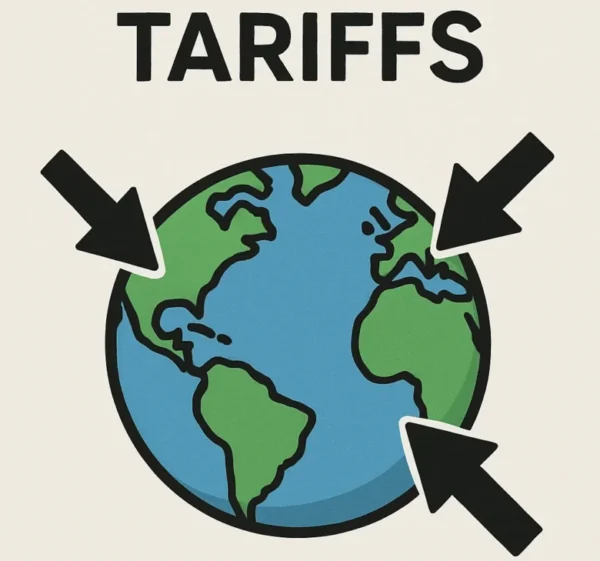
President Trump’s 245% tariffs on Chinese goods and tariff pause for EU, Canada until July 8, 2025, disrupt markets. Dow drops 699 points as trade, prices, and alliances shift.
Markets Tumble, Global Trade Braces for Impact—July 8 Deadline Hovers
Following President Donald Trump’s April 9, 2025, decision to pause tariffs for most trading partners while imposing a 125% tariff on Chinese exports, the administration doubled down on April 11, announcing targeted tariffs of up to 245% on specific Chinese goods, including electric vehicles and syringes. This escalation, coupled with a continued tariff suspension for allies like the EU and Canada until July 8, 2025, has roiled markets and redefined global trade dynamics. This article updates last week’s tariff developments, diving into the reasons behind the China tariffs, global reactions, and what lies ahead.
Markets Reel as Tariffs Bite
The announcement of the 245% tariffs on select Chinese imports triggered a sharp market correction. On April 16, 2025, the Dow Jones Industrial Average fell 699.57 points (1.73%) to close at 39,669.39, the S&P 500 dropped 118.93 points (2.24%) to 5,275.70, and the Nasdaq Composite slid 515.31 points (3.07%) to 16,307.16. The declines reflect fears of disrupted supply chains and higher consumer prices, particularly for tech and automotive sectors reliant on Chinese components. Meanwhile, markets in allied nations showed mixed responses, with Europe’s STOXX 600 dipping 0.8% but India’s BSE Sensex climbing 321 points to 80,112.45, buoyed by hopes of trade redirection.
EU and Canada Solidify Gains
The European Union, exporting $576 billion in goods to the US annually (2024 data), continues to benefit from the tariff pause. European Commission President Ursula von der Leyen reiterated her push for a “zero-for-zero” tariff deal, emphasizing stable transatlantic trade. Germany’s Friedrich Merz called the pause a “window for negotiation,” eyeing tariff-free access for cars and machinery. A $30,000 Volkswagen Golf could remain free of the $3,000-$6,000 price hike threatened by earlier tariffs, a relief for US buyers.
Canada, with $421 billion in US exports (2024), maintains its quiet advantage. The tariff suspension averts a 15% hike on crude oil (40% of US oil imports), keeping gas prices near $4 per gallon rather than $4.50. Canadian lumber, vital for US construction, avoids cost spikes, ensuring a $500 deck project doesn’t balloon. Both nations are leveraging the July 8 deadline to secure long-term trade deals, potentially deepening North American supply chains.
China Faces 245% Tariffs, Strikes Back
China, already grappling with a 125% tariff, now faces 245% duties on targeted goods like electric vehicles (EVs) and syringes, combining existing 100% tariffs from the Biden era with new 145% levies and a 20% fentanyl-related tariff. The White House cites China’s export restrictions on critical minerals—gallium, germanium, and rare earths, vital for semiconductors and defense—as a key trigger, alongside China’s retaliatory 125% tariffs on US goods, up from 84% on April 9, 2025. Beijing’s suspension of heavy rare earth exports further escalated tensions, threatening US industries reliant on China for 80% of these materials.
China’s Foreign Ministry urged the US to de-escalate, calling its own tariffs “necessary countermeasures.” Beijing signaled openness to talks but demanded “mutual respect,” while reportedly halting Boeing part orders and seeking EU partnerships to offset losses. For US consumers, the impact is stark: a $40,000 Chinese-made EV could jump to $98,000, and syringe shortages could raise healthcare costs. A $100 iPhone component cost could rise by $50 if supply chains falter, given China’s 30% share of semiconductor parts.
India’s Moment ?
India, with $83 billion in US exports (2024), sees opportunity amid the US-China rift. The NSE Nifty gained 112 points to 24,321.10 on April 16, reflecting optimism for trade deals in pharmaceuticals and tech. Indian drugs, already competitive, could drop a $20 prescription to $15 if tariffs on Chinese alternatives persist. India’s push for “Made in India” supply chains positions it as a potential alternative to China, though scaling up remains a challenge.
Trade Figures and Tariff Impacts
The US imports $3.1 trillion annually (2024 estimate), with the EU at 19%, Canada at 14%, and China at 13%. The 245% tariffs on Chinese goods aim to shrink China’s share, redirecting trade to allies. The EU and Canada could gain ground if July 8 talks succeed, while India eyes a larger slice. However, closing the “de minimis” loophole—previously allowing tax-free Chinese imports under $800—hits e-commerce giants like Shein, potentially raising apparel costs by 20%. US exports ($1.8 trillion in 2024) face risks if China retaliates further, targeting the $150 billion in US goods like soybeans it imports.
Shifting Global Alliances
The tariff escalation splits trade into clearer camps. The EU and Canada are accelerating talks to lock in tariff-free access, possibly reducing reliance on US markets long-term. China, leveraging its Belt and Road Initiative (BRI), launched in 2013, is redirecting goods to Asia, Africa, and Europe to counter US tariffs. By 2023, China had invested over $1 trillion in BRI projects across 149 countries, building railways, ports, and highways that enhance trade routes independent of the US market. This long-term strategy, aiming for major milestones by 2049, mitigates the impact of the 245% tariffs by diversifying China’s export destinations, with 2023 deals worth $92.4 billion signaling sustained momentum. Meanwhile, China’s 5.4% GDP growth in Q1 2025 underscores its economic resilience. The US is isolating China through deals with 70 trade partners, offering tariff relief for limiting Beijing ties. For consumers, this means more European cars and Canadian oil but pricier Chinese tech—a $200 smartwatch could hit $250 by July.
The 90-day tariff pause for allies offers a chance to stabilize trade, but the US-China standoff threatens broader disruption. Success with the EU and Canada could keep gas at $4 and imports affordable, while a prolonged China conflict might add $50 to a laptop’s cost by year’s end. The WTO predicts an 81% drop in US-China trade, hinting at economic decoupling. By July 8, we’ll see if Trump’s strategy reshapes global trade or sparks a costlier shakeup. For now, consumers brace for higher bills, and markets watch warily.






